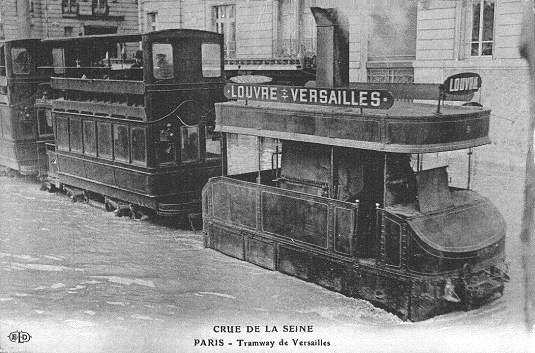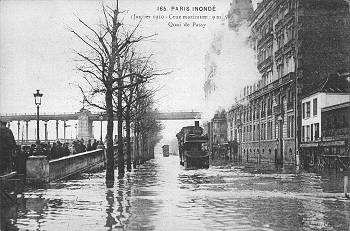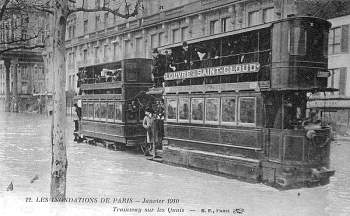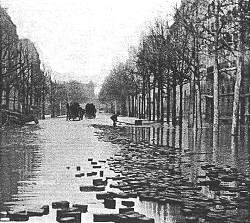

The main postcard, from the "ELD" series of Parisian publisher Eugène Le Deley, is captioned "Tramway de Versailles" and is on the Quai de Passy. It shows former Mékarski compressed air locomotive number 9 as converted to the Purrey steam system, pulling two trailers during the Seine floods of January 1910 on the Louvre to Versailles route.
Of the smaller views, the second card (below), also on the Quai de Passy, is number 165 in a series by Parisian card publisher A. Noyer and shows a similar tram and the extent of the floods, informing us that the maximum height of the water was 9.5 metres. The third view is of a Mékarski 1900 series compressed air tram and trailer on the Louve to Saint-Cloud route, again at the same location and is from the Paris publisher "B.P.". All these trams were owned by the Compagnie Générale des Omnibus. (See also Compressed Air Trams). The fourth view is taken from an official photograph and shows the Avenue Bosquet, where conduit tracks are under water and the wood paving blocks are afloat.
 The floods began on 21st January 1910, and for the next week caused absolute chaos to the transport systems of Paris, so much so that on 2nd February Monsieur Alfred Picard was appointed as president of a flood commission, which by 18th April had reported on the floods with recommendations on how problems could be avoided in the future. Of the 53 km of Métropolitain railway open in the city at the time, some 19.4 km were flooded as well as 7.5 km of the 20.5 km that were in course of construction. The main line railways entering the capital were similarly affected. Bus services were severed due to roads being blocked or damaged by subsidence. It was the end of February before most transport returned to normal.
The floods began on 21st January 1910, and for the next week caused absolute chaos to the transport systems of Paris, so much so that on 2nd February Monsieur Alfred Picard was appointed as president of a flood commission, which by 18th April had reported on the floods with recommendations on how problems could be avoided in the future. Of the 53 km of Métropolitain railway open in the city at the time, some 19.4 km were flooded as well as 7.5 km of the 20.5 km that were in course of construction. The main line railways entering the capital were similarly affected. Bus services were severed due to roads being blocked or damaged by subsidence. It was the end of February before most transport returned to normal.
Our main field of interest, the tramways, suffered on a number of fronts with all ten Paris tramway companies that worked the central area being affected to some extent. Flooding was not just due to the Seine overflowing its banks, but also due to backing up of water in drains and sewers remote from the river itself. Some rails were distorted and tracks became impassable. In a number of cases the wood blocks of the road surface were forced up by water pressure leaving the rails unsupported, with these same blocks floating away only to form a log-jam and obstruct tracks elsewhere.
 If flood water was less than 30 cm deep, trams could slowly proceed. Steam trams had to avoid water coming above the level of the firebox. Purrey steam cars performed very well. Electric cars, including accumulator cars, could not be used if the water reached their motors. In the case of electric cars powered by conduit or surface contact studs, service was terminated immediately due to short circuits. Even after the flood subsided, the conduit was left full of mud and detritus. Electric cars were also very badly affected when the floods reached the power stations and supply was cut. Flood water could not be allowed to reach the boilers and there was difficulty in delivering coal and clean water. Compressed air cars worked quite well on the road but suffered the same problems as electric cars when their air-supply generating stations flooded, particularly that at Billancourt serving the lines at Auteuil.
If flood water was less than 30 cm deep, trams could slowly proceed. Steam trams had to avoid water coming above the level of the firebox. Purrey steam cars performed very well. Electric cars, including accumulator cars, could not be used if the water reached their motors. In the case of electric cars powered by conduit or surface contact studs, service was terminated immediately due to short circuits. Even after the flood subsided, the conduit was left full of mud and detritus. Electric cars were also very badly affected when the floods reached the power stations and supply was cut. Flood water could not be allowed to reach the boilers and there was difficulty in delivering coal and clean water. Compressed air cars worked quite well on the road but suffered the same problems as electric cars when their air-supply generating stations flooded, particularly that at Billancourt serving the lines at Auteuil.
Tram depots were flooded. Specifically, the Compagnie Générale des Omnibus's Lyon depot (Avenue Ledru-Rollin) had to be evacuated, with cars being serviced at the Place de la Bastille, and water entered the Tramways de Paris et du Departément de la Seine depots at d'Asnières and Puteaux. The Chemins de Fer Nogentais depot at Maltournée was completely flooded when full of cars as the River Marne broke its banks. Other depots and their generating stations suffered as well. Motors and accumulators on many Paris trams were damaged by the water getting into them.
Perhaps the most serious problem for the electric tramways was when the central power generating station of the Compagnie Générale de Distribution d'Energy at Vitry came under the waters on 23rd January. The resulting severance of supply caused most of the Paris electric tramways to come to a halt, as this was the main power source for most of the tramway companies.
 M. Picard's report had a number of recommendations for tramways. At the same date, consideration was being given to combining all the Paris tramways into one company, so the report was particularly relevant. In future, power stations, sub-stations and tram depots would need to be protected from flood water entering and their fuel and water supplies should be secured. Depots should ensure that they could be evacuated quickly. The facility should be made available so that power could be supplied alternatively from other stations in safer locations, with watertight underground cable and junction boxes provided so that faults could be isolated more easily. It was suggested that track level current collection systems should not be used in areas liable to flooding.
M. Picard's report had a number of recommendations for tramways. At the same date, consideration was being given to combining all the Paris tramways into one company, so the report was particularly relevant. In future, power stations, sub-stations and tram depots would need to be protected from flood water entering and their fuel and water supplies should be secured. Depots should ensure that they could be evacuated quickly. The facility should be made available so that power could be supplied alternatively from other stations in safer locations, with watertight underground cable and junction boxes provided so that faults could be isolated more easily. It was suggested that track level current collection systems should not be used in areas liable to flooding.
The most notable outcome of the inundation was the demise of the surface contact stud systems, as their mechanisms were ruined by the flood water. Permission was gained to put up temporary overhead so the service could be quickly resumed (on 20th February) and of course it became permanent. This saw the end of all the Dolter studs of the Compagnie de Chemin de Fer du Bois de Boulogne and of the Diatto studs of the Est Parisien on its lines on the "Quais", with the remaining studs of Est Parisien at their other locations being replaced in 1913 in line with the report recommendations.
![]() Go to Postcard Of The Month Index
Go to Postcard Of The Month Index